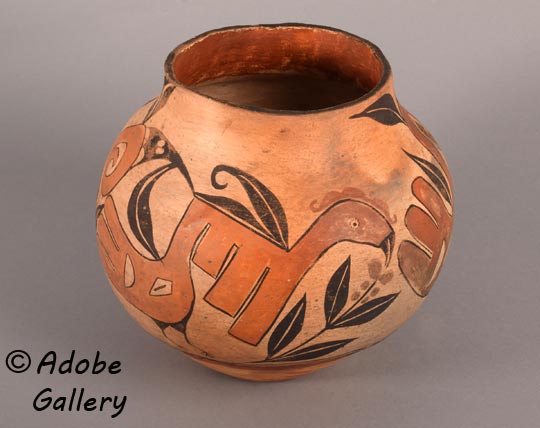Acomita circa 1850-1860s Jar with Elaborate Parrot Designs [SOLD]
+ Add to my watchlist Forward to Friend
- Category: Historic
- Origin: Acoma Pueblo, Haak’u
- Medium: clay, pigment
- Size: 10-¼” height x 11-¼” diameter
- Item # C4864 SOLD
This jar appears to be on the cusp of Acomita Polychrome and Acoma Polychrome typologies. The two categories overlap in the mid-1800s and that appears to be the period of this jar. The jar does not possess the vessel shape of early Acomita Polychrome jars, but its shape is closer to those from the early period of Acoma Polychrome. It has a mid-body bulge that curves upward to a simpler neck. Acomita jars are very globular and have a distinctive collar neck.
Somewhere, sometime, somebody established names for different periods of pueblo pottery. Excavations at prehistoric sites unearthed hundreds of years of pottery examples and names were assigned to each period.
At today's occupied pueblos, archaeological excavations are generally not permitted. One very limited excavation permitted at Acoma in the early 20th century revealed that earlier pottery was decorated glazeware—designs applied with a paint containing lead ore. From excavated examples Frank Harlow was able to extrapolate that Acoma glazeware spanned the years from 1300 to 1700.
Pottery naming is not arbitrary but consists of two parts—first word being place of origin and the second being an attribution. Starting after the period of glazeware in 1700, the first category at Acoma is Ako Polychrome, 1700-1820—Ako being the official name of Acoma Pueblo and Polychrome being more than two colors. Next is Acomita Polychrome, 1780-1850, Acomita being one of the farming villages at the base of the mesa. Lastly, there is Acoma Polychrome, 1840 to present, Acoma being the current accepted name of the pueblo today.
This jar has the weight and thick vessel walls associated with Acomita Polychrome jars. Acoma Polychrome jars, particularly 20th-century ones, have very thin walls and are very light in weight. The underside of the jar is concave, and the lower section of the jar is natural clay without slip application. There is a distinctive puki line at the lower section. A wide red band separates the lower section from the painted section. It appears that there is no slip on the body of the jar. The designs were painted on the natural clay body that appears to have been polished prior to being painted.
According to Lanmon and Harlow, the globular shape of the body is a trait of Acomita Polychrome. The most significant feature of this jar is the orange band, lying just below the lower edge of the design area. Banding like this is not a trait of Acoma pottery, however it is more likely a more common feature of Laguna pottery. Vessels with red bands exist from Rio Grande pueblos and at Zia and Santa Ana. Laguna consists of a large number of people from pueblos who use red banding, so it is conceivable that this jar was made at Laguna, but still qualifies as an Acomita Polychrome.
The designs cover the area of the jar from the lower wide red framing line to the painted black rim without a separation at the neckline. This is typical at Laguna Pueblo during this period as well as at Acoma. The parrots are unusual in composition. The neck of the parrot with a realistic head and body is squared off with rectangular protrusions. They are perhaps neck feathers. The other bird is featured with a spiral for its head. Otherwise, the body was rendered in traditional bird form. Another comment from Harlow and Lanmon is that "Some later jars have spirals with such complicated embellishments that their existence is not immediately discerned.
The bird with the realistic head is devouring berries from the nearby plant. The other bird has no such luck. Both birds are surrounded by black split-leaf plants.
Designs on both periods of Acoma and Acomita pottery are all over the scale because designs were the product of individual potters, and much creativity has been observed in the many jars collected from both periods. The use of parrots on jars is more related to early Acoma Polychrome than to late Acomita Polychrome. The parrot design was not necessarily a result of Spanish influence, which it has been tied to by some observers. Colorful birds such as macaws were at Acoma before the arrival of Spanish Conquistadores. Trade with Mexican Indians was well established before 1600. Acoma potters were familiar with colorful birds but, still, parrots are seen on more pots after 1880 than on those of an earlier date.
In summary, the vessel shape of this jar is closely related to those of early Acoma Polychrome rather than to late Acomita Polychrome. The weight of the jar and the wall thickness are more associated with Acomita Polychrome than with Acoma Polychrome. The parrot design appears more like mid-1800s Acoma Polychrome design than to designs on most Acomita Polychrome jars. Based on these observations, this jar appears to be in the transitional period of the two typologies—dating between 1840 and 1860.
Condition: very good condition for its age
Provenance: this Acomita circa 1850-1860s Jar with Elaborate Parrot Designs is from the collection of clients from California
Reference: Lanmon, Dwight P. and Francis H. Harlow. The Pottery of Acoma Pueblo. "Acomita Polychrome Jars with Polychrome Decoration" pp 108-113.
TAGS: Southwest Indian Pottery, Acoma Pueblo, Historic Pottery

- Category: Historic
- Origin: Acoma Pueblo, Haak’u
- Medium: clay, pigment
- Size: 10-¼” height x 11-¼” diameter
- Item # C4864 SOLD
Adobe Gallery Recommended Reading
Adobe Gallery Recommended Items
If you are interested in this item, we would also like to recommend these other related items:



